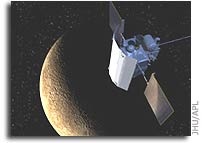NASA MESSENGER Mission News: Priming Instruments to Map Mercury’s Crust

Understanding if ice exists on the surface of Mercury, and if so what types, will mark an important component of the investigations by the MESSENGER spacecraft about the origin and evolution of the solar system’s inner planets. This month, instrument engineers at the Johns Hopkins University Applied Physics Laboratory in Laurel, Md., turned on the Neutron Spectrometer (NS)-one of several sensors aboard MESSENGER that will be key to sorting out the mystery of Mercury’s surface.
The NS will collect data about the composition of the uppermost tens of centimeters of Mercury’s crust by measuring the numbers and energies of neutrons that reach the MESSENGER probe as it passes near the planet. The NS together with a gamma ray sensor make up the Gamma-Ray and Neutron Spectrometer (GRNS) instrument.
The NS will map variations in the fast, thermal, and epithermal neutrons Mercury’s surface emits when struck by cosmic rays. “Fast” neutrons shoot directly into space; others collide with neighboring atoms in the crust before escaping. If a neutron collides with a small atom (like hydrogen), it will lose energy and be detected as a slow (or thermal) neutron. Scientists can look at the ratio of thermal to epithermal (slightly faster) neutrons across Mercury’s surface to estimate the amount of hydrogen-possibly locked up in water molecules-and other elements.
Subtracting the Background Noise
APL’s Edgar Rhodes, an instrument scientist on the MESSENGER mission, says the current NS calibration will “tweak the electronic thresholds and voltages for the detectors to assure that the most interesting parts of the neutron spectra are within the energy ranges of the instrument before the upcoming second Venus flyby on June 5.”
In space, the spacecraft is bombarded continuously from all directions by galactic cosmic rays, high-energy particles (mostly protons) thought to originate from remnants of supernovae in our galaxy, explains APL’s John Goldsten, the GRNS instrument engineer.
“On Earth, we are protected from these penetrating rays by our atmosphere; but in the vacuum of space they collide directly with spacecraft materials, smashing into atomic nuclei, and sending off energetic neutrons,” he says. “These energetic neutrons, in turn, collide with other atoms and produce a host of lower-energy neutrons and gamma rays. These signals pose a serious background in the instrument that needs to be ‘subtracted out’ from the total signal measured near a planet. After all, it’s the composition of the planet and not the spacecraft we are trying to measure.”
To make matters more difficult, Goldsten adds, some components of this induced spacecraft background build up over time, “and so it is important to make periodic measurements to characterize this background to perform a proper analysis and interpretation of the science data.”
Searching for Solar Neutrons
The NS will remain on during most of MESSENGER’s cruise phase and return data from Venus flyby 2 in June, three Mercury flybys in 2008 and 2009, and one Earth year in Mercury orbit starting in 2011.
The NS is a low-power instrument that can safely be powered on indefinitely, Goldsten says. “We plan to take special advantage of the unique measurements the NS can produce as it journeys through the inner solar system; a region of space never before studied with this type of instrument.”
“Looking for the presence of energetic neutrons streaming away from the Sun during solar flares is of particular scientific interest to physicists trying to model and understand the underlying mechanisms of solar activity,” he continues. “Solar neutrons are very difficult to observe from Earth because these sub-atomic particles by themselves-not bound inside an atomic nucleus-are not stable and decay away in about ten minutes, so only the most energetic (fastest moving) neutrons reach Earth before disintegrating, and these are very few. But as the MESSENGER spacecraft journeys closer to the Sun and gets inside the orbit of Venus, the likelihood of observing solar neutrons increases dramatically because we get a chance to capture them before they can decay away.”
Another reason to operate the NS during the long cruise to Mercury is to help the Interplanetary Network of satellites detect and locate Gamma Ray Bursts-the most energetic events known in the Universe-which produce monstrous flashes of gamma rays that appear in the sky at random times and from random locations.
“Detecting these gamma ray bursts simultaneously at distant spacecraft helps to triangulate their direction so that observatories can quickly aim powerful telescopes to study the optical counterpart or ‘afterglow’ of these colossal events, hypothesized to mark the collapse of stars into black holes or the collision of super dense neutron stars,” Goldsten says. “While the NS is optimized to detect neutrons, gamma rays appear as a steady background signal, so any sudden changes in this background signal can be used as a gamma-ray burst monitor. Gamma-ray bursts are typically detected about once a day, and no two are exactly alike; some last milliseconds, while others may continue for minutes.”
From an engineering point of view, the GRNS is a flexible instrument with many controls and settings that can be adjusted remotely via commands to the spacecraft. “This flexibility is important as we cannot easily simulate the galactic cosmic ray environment on the ground,” Goldsten says. “Optimizing the in-flight settings is usually an iterative process where we make small changes and then analyze the results. We then collect long-term data with the final settings to establish the instrument baseline prior to an encounter such as the upcoming Venus flyby.”
More information about the GRNS is available online at http://btc.montana.edu/messenger/instruments/grns.php








